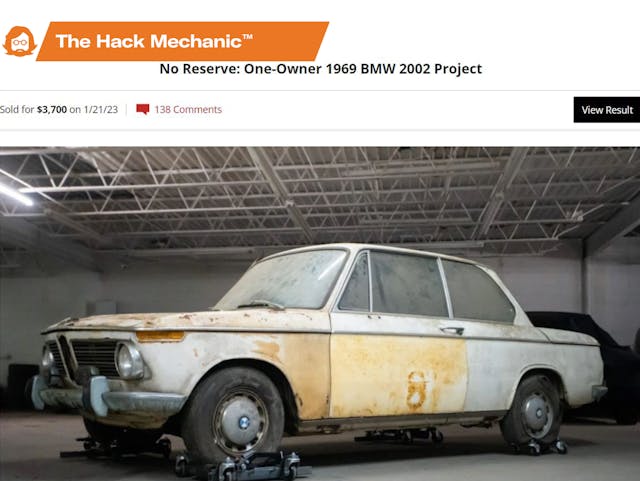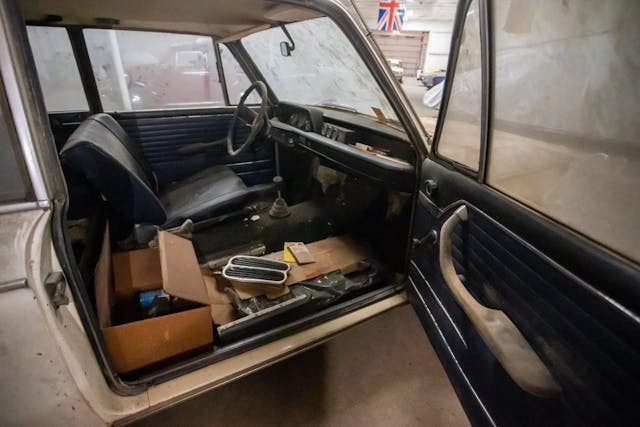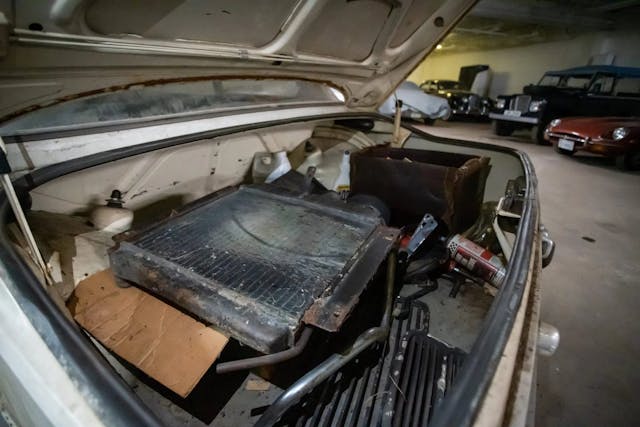The basket case BMW 2002 on BaT

I spend far less time on Bring a Trailer than perhaps you’d think. There are reasons for this. The primary one is that one of Rob Siegel’s Tips For Sane Living™ is “don’t crave things you can never have.”
So the carnival of vintage Ferraris, insanely-low-mileage Porsches, and oh-my-god-I-thought-this-car-was-an-urban-myth vehicles rarely make me lift my head out of whatever well-worn road-trip veteran I happen to be wrenching on, or whatever affordable needy classic I happen to be chasing.
The secondary reason is that nearly all of my meager income comes from automotive writing. While I marvel at the success of BaT’s business model that crowdsources free expertise under the guise of social media, I feel very little desire to contribute. It’s like bar and restaurant owners expecting musicians to play for exposure instead of money. If I want to bathe myself in social media, I can do it on Facebook and serve my own agenda, not BaT’s.
However, if someone sends me a link to an auction that they want my opinion on, or one that includes my “thehackmechanic” BaT handle in a comment that automatically generates an email, I’ll have a peek. For the most part, if the link is some best-of-the-best car that causes a hedge-fund manager and a real estate agent in Beverly Hills to bid against one another, I move on because I really don’t care.
But in late January, three people invoked my name in comments on an interesting basket case 1969 BMW 2002 on BaT. So, like Beetlejuice, I was summoned.
The auction was titled “No Reserve: One-Owner 1969 BMW 2002 Project.” The photos showed a long-neglected, heavily patina-laden Chamonix (white) 2002 that was wearing the mummy-like dust of lengthy storage but was sitting on wheel dollies in a well-lit warehouse surrounded by other nice-looking classics. It was sort of an odd juxtaposition.

The fact that this car was on Bring a Trailer at all drew quite a number of positive “BaT getting back to its roots” comments, and I suppose that there’s something to be said for that. After all, the majority of cars up on BaT are buffed and polished eye-candy—cars where the buyer brings a trailer to keep the dirt off his or her new purchase, not because the car is a long-dead project.
At first glance, the body of the 2002 appeared shabby but solid, meaning that there weren’t plainly visible, fist-sized holes in the corners of the front fenders as is often the case on abandoned-in-place 2002s. However, as you clicked through the photos, you came to ones that showed the hood and trunk lid both so badly rusted that the BMW emblem was literally falling off. The description said the car was being sold on behalf of its original owner, a gentleman who had parked the car in his garage in 1979 due to a bad clutch slave cylinder. At some point, the garage’s roof reportedly began leaking, which is what reportedly caused the car’s odd top-down rust. Very sad, especially considering how easy it is to replace a slave cylinder.


The seller used the term “barn find.” In my opinion, the whole “barn find” thing is largely a load of BS. I understand that the mystique is that it connotes that the car is a fully original time capsule, but there’s nothing about dust, mold, mildew, spider webs, and rodent droppings that make a car pure and unmolested. Roll the car out of the barn, begin itemizing its issues, and the aura of originality usually gets blown away by the stiff wind of real-world needs with real-world costs. From a purely practical standpoint, a recently running car with perhaps a few ill-chosen modifications will be much easier to revive than something that’s been sitting since the Soviets invaded Afghanistan and when people thought John Travolta was a great dancer.
Further, this was not a completely intact car. The radiator and other parts were sitting in the trunk. The passenger seat and rear seat had been removed, though they were included. The console was missing.
A few weeks ago, I wrote a two-part series on how to sell a car (part 1 and part 2). While not everyone has to do exactly what I do, it’s generally to the seller’s benefit to provide a thorough description of a car and give it some appropriate level of preparation. I joked that the latter doesn’t need to be much more than running it through a car wash and throwing out the Dunkin’ Donuts cups, but it’s true. It seemed odd to me that someone would go to the effort to drag a car like this out of the garage where it had been sitting for 44 years (and from the presence of the wheel dollies, “drag” must’ve been the operative verb), transport it to what the seller referred to as “our private auto museum,” and photograph it without bothering to clean the dust and grime off the windows, vacuum up the schmutz under the hood, and remove a Styrofoam coffee cup and an umbrella from the back floor.

Further, as the photos show, there was a good deal of stuff in the car and trunk. The car would’ve been better represented had the seller taken it all out for the photos. Then the rugs could’ve either been peeled back to show the condition of the floors, or the seats could’ve been put in, giving the car the image of being intact and complete. To do neither under the auspices of it being a “barn find” seemed a cop-out. The seller seemed to regard this as a point of pride, as he wrote, “I made sure not to disrupt the car from the way it was when we pulled it out of that garage.” I’m sorry—it’s not a crime scene or Native American burial site. I could relate to one commenter, who took the seller to task: “Don’t they have Windex in Virginia? Or shop vacs? It seems by not lifting much of a finger you’re kinda maybe giving the auction a little bit of a different kind of a finger.”


One of the things I say over and over about selling vintage cars is that by meticulously documenting a car’s condition, you remove questions about what the car might be and instead reveal what it actually is. This removes risk to the buyer, and therefore likely increases the number of bids. While there were 211 photographs, many were redundant shots of the outside of the car. Photos of the shock towers were provided, and there were a few shots of the rocker panels, but the only undercarriage pics were what could be photographed from floor level. While it’s non-trivial getting detailed undercarriage photos of a dead car, if you have a “private museum,” don’t you also have a lift? Or at least a floor jack?


In addition to inadequate undercarriage photographs, the seller stated, “I have not tried to turn the engine over by hand.” Several commenters asked for a definitive answer regarding whether the engine was seized, and the seller simply repeated his stance. This mystifies me. Especially with the radiator out of the car, it’s 10 seconds worth of work to put a 30mm socket on the crankshaft nut and try to turn the engine. If the seller didn’t have one, he could’ve tried to rotate it by grabbing the fan. If that didn’t work, he could’ve simply said so.
Now, I’ve been tough on the seller here. Let me back off. As I said in my piece, it’s a lot of work selling a car, and this one wasn’t even his. In fairness, there’s zero question that the seller did the owner a huge favor by getting the car out of what was presumably a cramped, decrepit garage and putting it in a well-lit space where it could be walked around and photographed. Considering that the car needed to be on wheel dollies, this alone was likely a substantial task. You may remember that I recently represented a 2002tii for a woman whose husband-owner had passed away. Bringing that car up to the condition where it was the best version of itself, describing and photographing it, and managing the sale was months of work. So, I totally get why the seller might have drawn the line where he did. But an hour or two more work may have made a non-trivial difference in the car’s sale price.
I’m very careful commenting on BaT auctions, as I once had a guy literally chew me out in public because he said I affected the value of his auction by commenting that the orange aftermarket color scheme of his interior wasn’t my personal taste (for the record, I only made the comment after the auction had closed, and it was hideous), but because three people had asked for my input on the basket-case 2002, I felt like I needed to comment. Other folks who know more than I do about the differences between early model year 2002s had already weighed in on the fact that the car was a largely original “first-series ’69” that carried with it some seldom-seen braking system components. To me, that was less of an issue than the car’s condition. I chose my words carefully:
“I’m pretty reticent about injecting my opinion here on BaT, as I have my own view of things, and they usually don’t involve spending a lot of money to turn X into Y. I wouldn’t touch any car without either crawling under it and examining the undercarriage myself or seeing a complete set of photos, especially one like this that already shows rust-through on the normally solid surfaces of the hood and the trunk lid, but I’m not going to be “that person” on BaT who asks for more photos but has no intention of bidding. I guess all I’ll add is that, even if it’s just revived and not restored, a car like this is going to need everything. If the undercarriage is in fact solid, and you want a ratty runner, and you can do all the mechanical work yourself, it could be a fun project. If, on the other hand, you want something where the end product is pretty and shiny … well, you can fill in the end of that sentence yourself.”
Actually, I have to admit that I was considering bidding on the car myself. After all, it did look pretty solid, bids were low even at the end, and it was close enough (it was in Virginia) for me to drag it home. But without further disclosure on the areas that I mentioned above, there was more risk in it than I was willing to take. Zero regrets.
It’s funny how small things can sway a decision. The rear half-shafts on most 2002 have CV joints at both ends. As long as the boots don’t tear, they’re incredibly long-lived. However, the photos for this car showed that this had one CV joint and one universal, and the CV boot had dissolved. While it’s not a big deal to swap half-axles, my knee-jerk reaction was, “To make the car drivable, I’d have to deal with this, too?” Moreover, it would be one of many decisions on originality—whether to just throw a used set of dual-CV half-axles in or pay to have these rebuilt. To me, it was the visible tip of the iceberg on the car needing everything.

But over and above the specifics of the BaT auction, I wanted to knock something around with respect to the value of a car like this, and what its future might be.
BMW 2002s are a huge part of my life. I’ve owned 40 of them. I currently own three. I know them well. Their value, particularly the 1968–73 round taillight cars in excellent condition, is quite strong. The Hagerty Valuation Tool lists values for a roundie 2002 as ranging from about $17K in fair condition to about $90K in concours condition. That sounds a bit high, but it’s more or less in line with the snapshot of as-sold values on BaT. The fuel-injected 2002tii is worth even more, and the rare Turbo more still. Hagerty doesn’t list values for cars in rough condition, and not many of them make it to BaT, so it’s more difficult to get a reliable metric on a car like this.
But, not to make too fine a point of it, a ’69 BMW 2002 is not a ’69 Porsche 911. A small-bumpered long-hood 911 in similar condition would probably be worth eight to ten times the $3800 that this car sold for. Folks would likely be falling over each other to laud the car’s originality, crow about what an easy restoration it would be, and bid on it. And the hypothetical 911 that pops out at the end, whether it’s a resurrected ratty runner, or a rolling repaint, or a full-blown restoration, would obviously be worth way more. This 2002 simply doesn’t have that kind of upside. Even considering that the worst rust on it is on the two easiest-to-replace body panels (the hood and the trunk lid), the car’s poor condition looks like it extends to just about everything. I’m a big believer in, as I said above about the widow’s 2002tii I helped sell, making a car the best version of what it already is. Taking a sow’s ear and trying to turn it into a silk purse becomes incredibly expensive. Unless you restore cars for a living, you’re generally better off buying a different car rather than trying to do so.
Further, despite the comments from 2002 purists on there being only a small number of first-series ’69s left and how cool it would be if this one was kept original and brought back to its former glory, my feeling is that the market doesn’t yet fully value such fine details on these cars. It certainly values a round taillight 2002, particularly a 2002tii, not being a complete Frankencar and having the right seats, dashboard, and instrument cluster as opposed to ones that time-traveled in from the later big-bumpered square taillight cars. But things like braking system details, I don’t know. Forcing all those details to be correct, as opposed to using more readily available parts from later 2002s, is likely to be an expensive layer on top of what would already be an expensive revival. If the car’s new owner wants to “correctly” “restore” it (I put both words in quotes because I hate both of them), that’s his call.
But if the buyer isn’t looking for perfection, if he does much of the work himself, if the frame rails and floors are free of rust-through, if the engine turns and is revivable with a fresh head gasket and a valve job, if the interior isn’t a gag-worthy water-damaged mouse-infested hazmat zone, and if he doesn’t get wrapped around the axle (or, in this case, the half-axle) of correctness, I think he’ll do handsprings over what he picked up. If I see the car in May at The Vintage (the annual low-stress BMW event in Asheville, North Carolina), hastily patched up and running, and making it there by the skin of its teeth, I’ll buy the new owner an evening’s worth of beers. If he just threw in a set of later half-axles, I’ll make that two evening’s worth of beers.
***
Rob’s latest book, The Best Of The Hack Mechanic™: 35 years of hacks, kluges, and assorted automotive mayhem is available on Amazon here. His other seven books are available here on Amazon, or you can order personally-inscribed copies from Rob’s website, www.robsiegel.com.


Calling Sam Smith. Son of Weissrat?
“I’m sorry—it’s not a crime scene or Native American burial site. ” Wonderful line! I’ll have to remember that one. 🙂 I’ve seen that too many times also. Generally associated with a price more toward the # 3 value rather than the # 5 or 6 value. 🙂 Fortunately this one was actually for sale rather than having a reserve price.
Don’t crave things that you could possibly have, but don’t have any room for
Many years ago an old-timer at a higher end restoration shop gave me some advice (I had been questioning the amazing restoration work being done on a barge of a Chrysler product that seemed an odd choice for such an investment). He said:
“The Thunderbird rule is a 55-57 T-bird can be bought for X or less and you always make money off it because they are worth Y when done. Fixing anything else costs about the same to do, but it better be a lot cheaper to get or worth a lot more than a finished bird if you are going to bother”.
While not sure that T-birds are such a good benchmark today, the premise is sound. The barge Chrysler was 60 grand over it’s market value at the time and the interior wasn’t finished. It was the owner’s heirloom baby so it was being done top-notch whether it made sense or not. If that person could afford that, good for them.
Hey Rob aka @thehackmechanic, you probably should shoot me an email. Added a literal “farm” find 02 last year that makes the one here like concourse.
1973 fjord blue tii.
P.S sorry for the year and change late comment but this came up when I needed a boost in faith and searched for “basket case 2002 project.”
Thanks for listening to my rant.